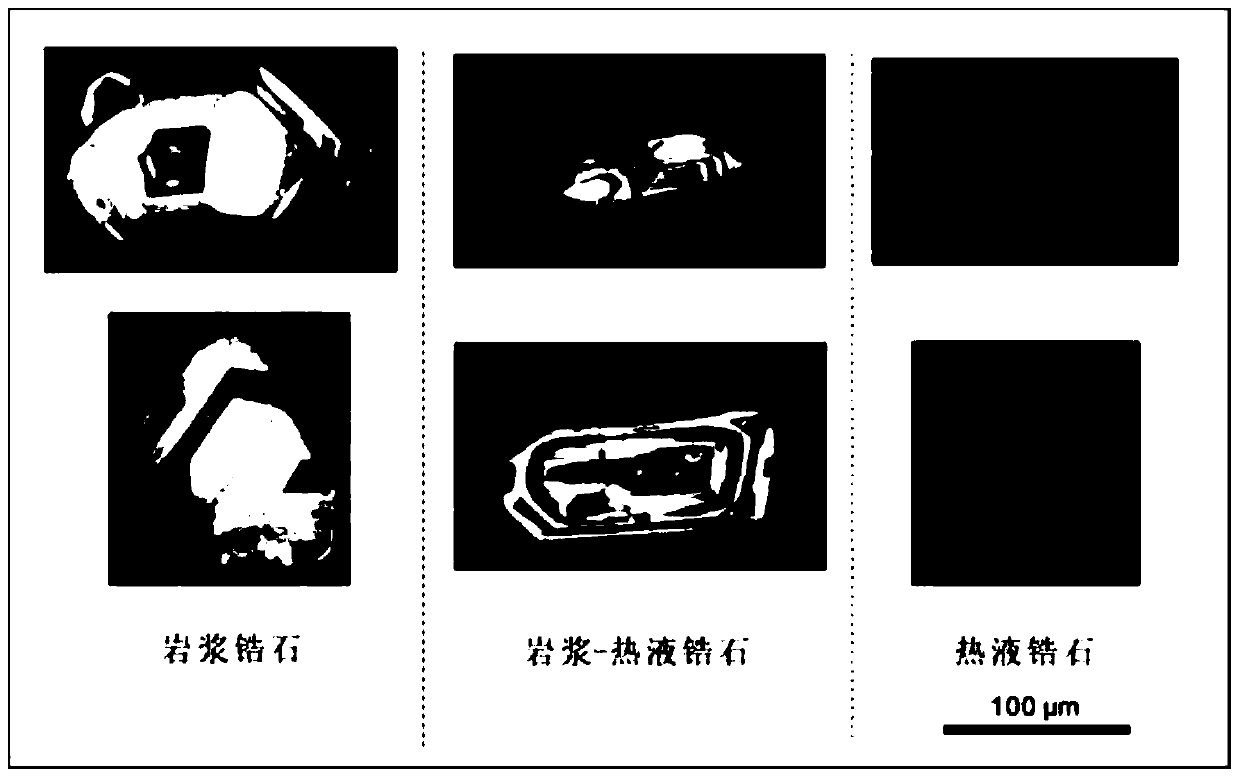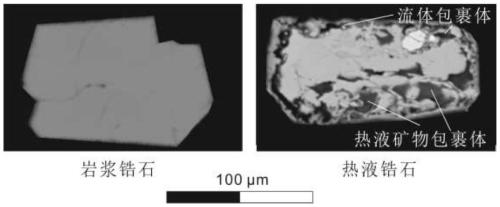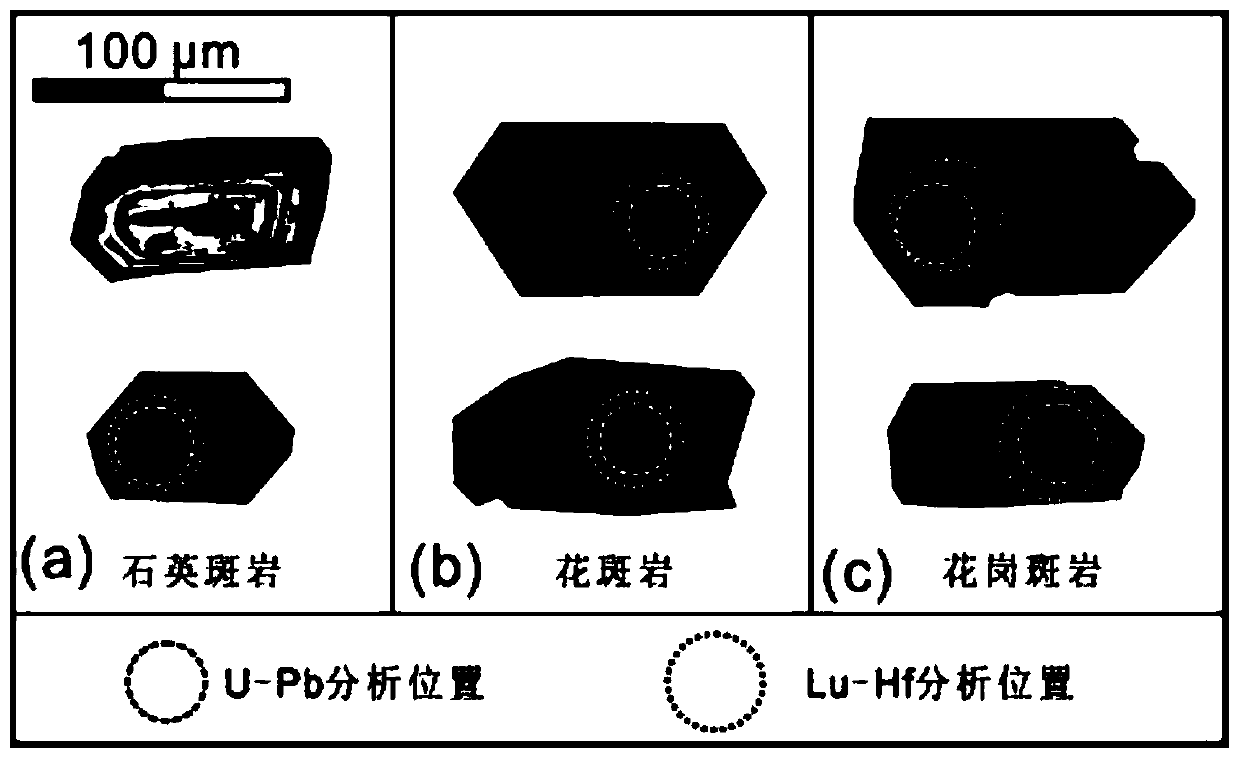Mineral exploration method for judging mineralization of granite body by using zircon
A granite and zircon technology, which is applied in the preparation of test samples, material analysis by wave/particle radiation, sampling, etc., can solve the problems of long period, low efficiency, and difficulty in finding ore in the deep edge of the deposit, and achieve The effect of shortening the prospecting cycle and saving costs
- Summary
- Abstract
- Description
- Claims
- Application Information
AI Technical Summary
Problems solved by technology
Method used
Image
Examples
Embodiment 1
[0073] Example 1 Analysis of different types of zircon in granite from tungsten-tin polymetallic deposits
[0074] The granites of various tungsten-tin metal deposits were collected, and zircon markers were obtained. CL images and BSE images were taken for the obtained markers, and the obtained images were compared and analyzed with the actual situation. figure 1 Typical CL images of different types of zircon shown and attached figure 2 Typical BSE images of different kinds of zircon shown. In the CL image, the left image is a typical magmatic zircon, which is white as a whole and has obvious internal oscillation rings; the right image is a typical hydrothermal zircon, which is black as a whole and has no internal oscillation rings; The middle picture shows a sample containing both magmatic zircon and hydrothermal zircon, which has both black and white parts, and an internal oscillation ring in the white part. In the BSE image, the left image is a typical magmatic zircon, a...
Embodiment 2
[0075] Example 2 Using zircon to judge the mineralization of the granite body of the Huangshaping tungsten-tin polymetallic deposit in Hunan
[0076] The inventors discovered multi-stage granite bodies in the Huangshaping deposit where tungsten-tin ore may exist, and selected three types of rock bodies that may be in contact with the ore bodies, namely quartz porphyry, flower porphyry and granite porphyry. The analysis process includes:
[0077] First, 100 zircon markers were randomly selected from each of these three types of granites for CL image and BSE image capture.
[0078] According to the obtained CL images, a large number of clear oscillating rings are developed in the zircon, which accounts for more than 50% of the quartz porphyry and piebaldite, as shown in the appendix. image 3 As shown in a and b, while the zircon in granite porphyry accounts for more than 50% of the total luminous intensity is weak and appears black in the CL image, as shown in the appendix. ...
Embodiment 3
[0087] Example 3 Using zircon to judge the mineralization of the granite body of the Xianghualing tin polymetallic deposit in Hunan
[0088] The inventor found multiple types of developed granites in the Leaziling pluton in Xianghualing, where there may be tin polymetallic deposits, and selected two types of rocks that may be in contact with the ore body, which are respectively albite granite and greisite granite for analysis. The analysis process is:
[0089] First, 100 zircons were randomly selected from each of three albite granite samples (XHL5-11, XHL6-2 and XHL7-3) and two grititized granites (XHL5-16-2 and XHL6-18) as Logo item.
[0090] CL images and BSE images were taken on the above-mentioned markers. According to the CL image, as attached Figure 8 It can be clearly seen that a large number of hydrothermal zircon with weak luminous intensity (black in CL) are developed in the zircon in these two types of rock bodies. Statistics show that the proportion of these z...
PUM
| Property | Measurement | Unit |
|---|---|---|
| diameter | aaaaa | aaaaa |
Abstract
Description
Claims
Application Information
 Login to View More
Login to View More - R&D
- Intellectual Property
- Life Sciences
- Materials
- Tech Scout
- Unparalleled Data Quality
- Higher Quality Content
- 60% Fewer Hallucinations
Browse by: Latest US Patents, China's latest patents, Technical Efficacy Thesaurus, Application Domain, Technology Topic, Popular Technical Reports.
© 2025 PatSnap. All rights reserved.Legal|Privacy policy|Modern Slavery Act Transparency Statement|Sitemap|About US| Contact US: help@patsnap.com



